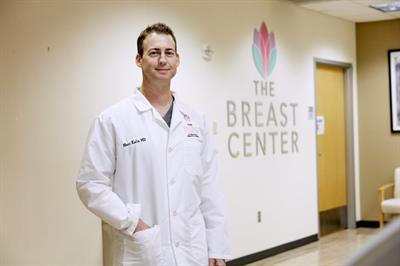Dr. Marc Kalis interviewed for Breast Cancer Awareness Month
Oct 14, 2019Dr. Marc Kalis is known from his quick biopsy readings. Women shouldn’t have to wait for test results and a diagnosis, he says.
As a radiologist for West Boca Medical Center for 10 years, Kalis is a proponent of early diagnosis. He’s on site at The Breast Center at West Boca Diagnostic Imaging, the hospital’s location in the Garden Shops at Boca.
Here’s Kalis’ detailed update on the latest treatments and alternatives for breast cancer patients.
Q: Do patients still lose their hair?
A: Hair loss is an unfortunate secondary side effect if chemotherapy is required to treat breast cancer. However, there are new innovations, such as scalp cooling devices.
Devices like these have been shown to reduce hair loss in as much as 65% of women undergoing treatment.
Scalp cooling involves a cap that reduces the temperature in the scalp during the chemo infusion. This reduces blood flow and metabolism within the hair follicle. That, in turn, helps protect the follicle from the toxins of chemo.
Q: Is there anything new in plastic surgery for patients who will need a mastectomy?
A: Early detection significantly reduces the likelihood of a major surgical procedure like mastectomy. If breast cancer is identified in an early stage, a less intrusive lumpectomy can be performed. Decades of research show that lumpectomy has an equivalent survival rate for early breast cancer.
If a mastectomy is necessary, more women are choosing breast reconstruction at the time of mastectomy. Newer surgical techniques using tissue flaps, with or without the use of implants. That has increased the likelihood of a more natural and aesthetically pleasing outcome.

Dr. Marc Kalis at The Breast Center
Q: Explain the stages of breast cancer.
A: The mortality rate has decreased between 30 and 40% since the 1990s. That’s since annual breast cancer screening became prevalent and new drug therapies emerged.
Breast cancer stage is based on the size of the primary tumor and the involvement of axillary lymph nodes or distant spread.
Stages range from 1-4 with stage 1 having the best prognosis and 4 having the worst. The smaller the cancer, the lower the stage and the higher the probability of survival. Again, early detection is incredibly important.
Q: Explain why it’s crucial to seek a diagnosis the minute there’s something wrong.
A: If the cancer is found early on, it is more likely to be smaller and confined to one part of the body. That makes it much easier to treat. The minute you feel an unusual lump, or a screening picks up something atypical, follow up. See your doctor or seek additional tests immediately.
Q: What symptoms should women look for?
A: Some patients can feel unusual lumps or experience nipple discharge or retraction. Look for skin changes like ulcerations, dimpling or crusting. However, for many patients, breast cancer can be silent and symptomless. It can be painless. Depending on the location of the cancer in the breast, it may not be possible to feel it.
That is why consistent screening is crucial. By the time the tumor can actually be felt, the stage can be advanced and harder to treat.
Q: Is there a site or YouTube you recommend?
A: The American Cancer Society no longer recommends monthly breast self-exam. Research has not shown a benefit and may contribute to an increase in false alarms.
With that said, women should be familiar with their breasts. Consult your doctor if you notice any changes. When breast cancer is palpable, tumors can feel like a firm, painless lump.
Q: Explain the different types of breast cancer.
A: There are two major types of breast cancer, depending where the cancer first develops. Ductal cancer is the most common form of breast cancers, and Lobular cancer. Breast cancers can also be broken down based on gene mutations or receptor types. If a breast cancer cell expresses too much estrogen or progesterone receptors, it may grow faster if these hormones are in abundance. This can happen during hormone replacement therapy, prescribed during menopause. Conversely, blocking these receptors can help treat the cancer, causing it to regress.
Q: Are younger women who still have hormones flowing more at-risk?
A: The biggest independent risk factor, other then being female, is age. The older you are, the higher your chances are of developing breast cancer. Depending on the receptor status of the cancer, younger patients may be at increased risk of tumor progression. That is because of increased estrogen and progesterone during certain phases of their menstrual cycle.
This is why it is so important to keep up your annual screening, despite advanced age. Most doctors would recommend patients continue screening as long as they feel healthy.
By Marci Shatzman, 19-year survivor.
